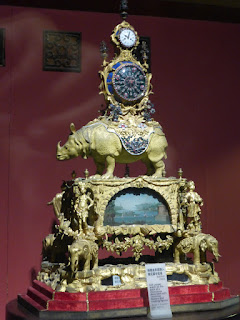There are quite a few attractive statues in the streets which I think are made of lead or cast iron.
These bullocks were actually within the Forbidden City not on the street.
The entrance to the Forbidden City. Closed to the public until 1914, the Forbidden City was the Chinese imperial palace from the Ming dynasty to the Qing dynasty through the years 1420 - 1912. It is the centre of Beijing and now houses the Palace Museum. It served as the home of emperors and their households as well as the ceremonial and political centre of Chinese government for almost 500 years. The vastness of the spaces is very hard to capture. The complex consists of 980 buildings.
The Forbidden City is immensely popular with Chinese tourists as well as with foreigners. European faces are however insignificant compared the large throngs of Chinese visitors.
Not sure what functions these traditionally dressed ladies served but they were rather photogenic.
One of the buildings housed watches and clocks from the time of the emperors. Foreign dignitiaries visiting China brought all sorts of fancy clocks as gifts to the emperor and these were treated with great enthusiasm. This gold encrusted clock with a rhinoceros motif is one of the more bizarre clock designs in the museum.
We visited the former residence of one of China's foremost poets, Qi Baishi, in a fashionable hutong, or residential area in a Chinese city, especially Beijing.
The colourful corridor outside the house.
Entrance to Beihai Park.
One of the many, many soldiers we saw standing to attention in green uniform and white gloves. We don't know if the 19th Communist meeting being held this week was the reason for so many soldiers or if they are always so prevalent.
Eating out seems as popular in Beijing as elsewhere in the world. We had lunch at a small worker’s café which was really cheap and then dinner at a much more upmarket one but not too flash. The food at the Peking Duck in Donghuamendian Street, just opposite our hotel was extremely nice and very reasonably priced. We would go as far as saying it was one of the best Chinese meals we have had. The soup came out in an enormous bowl and we had not several but a never ending stream of servings from it. When we ordered two soups the waitress advised that one was enough and when it came out we were extremely grateful for her sound advice.
This photo does not provide the dimension and depth required to appreciate the size of this bowl of soup. You need to see it in relation to the bowl you eat out of.
On this note we will leave our visit to Beijing. It was quite an experience and enjoyable too. An interesting city. I wouldn't like to live there but is was well worth a visit.

















No comments:
Post a Comment